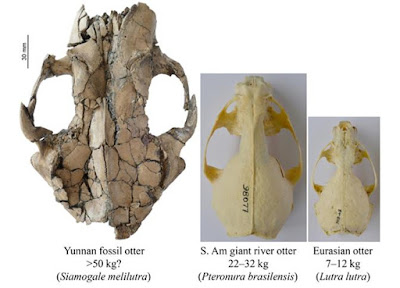 |
| Siamogale melilutra
Wang, Grohé, Su, White, Ji, Kelley, You & Yang, 2017
|
Abstract
Otters (subfamily Lutrinae) are semi-aquatic predators in the family Mustelidae. Modern otters have a worldwide distribution but their fossil record is poor, often consisting of fragmentary jaws and teeth. Multiple lineages have developed bunodont dentitions with enlargements of molars, usually for cracking molluscs or other hard foods. Some lineages have evolved badger-like teeth and, as a result, were often confused with melines (Old World badger clade). Siamogale thailandica Ginsburg, Invagat, & Tassy, 1983 from the middle Miocene basin of Mae Moh in northern Thailand is one such species, whose fragmentary dental remains have thus far impeded our understanding. A new species of fossil otter, Siamogale melilutra sp. nov., represented by a nearly complete cranium, mandible and partial skeletons of at least three individuals, was recovered from the latest Miocene (∼6.2 Ma) lignite beds of the Shuitangba Site in north-eastern Yunnan Province, south-western China. Computed tomography (CT) restoration of the crushed skull reveals a combination of otter-like and badger-like cranial and dental characteristics. The new species belongs to the Lutrinae because of its possession of a large infraorbital canal and ventral expansion of the mastoid process, among other traits. A distally expanded M1, however, gives a badger-like appearance. In overall morphology the Shuitangba otter is closest to Siamogale thailandica. A previously described jaw (‘Lutra’ aonychoides) from the early Pliocene of the Yushe Basin in north China is also here referred to S. melilutra. No previous attempt has been made to provide a global phylogenetic framework for otters. We present the first combined morphological and molecular (nuclear and mitochondrial DNAs) character matrices of five extant (Pteronura, Lontra, Enhydra, Aonyx, Lutra) and eight extinct genera (Tyrrhenolutra, Paralutra, Paludolutra, Enhydritherium, Siamogale, Vishnuonyx, Sivaonyx, Enhydriodon) to better understand the evolution of bunodont otters. Parsimony and Bayesian analyses consistently recover an eastern Asian clade that includes forms from Shuitangba, Yushe and Mae Moh, all of which are referred to Siamogale.
Keywords: Miocene, fossil otter, lutrine, phylogeny, China, Southeast Asia
Systematic palaeontology
Order Carnivora Bowdich, 1821
Infraorder Arctoidea Flower, 1869
Parvorder Mustelida Tedford, 1976
Family Mustelidae Fischer de Waldheim, 1817
Subfamily Lutrinae Bonaparte, 1838
Siamogale Ginsburg, Ingavat & Tassy, 1983
Type species: Siamogale thailandica Ginsburg, Ingavat & Tassy, 1983.
Included species: Siamogale thailandica Ginsburg, Ingavat & Tassy, 1983 and Siamogale melilutra sp. nov.
Emended diagnosis:
Siamogale has typical lutrine cranial and dental morphologies: a large infraorbital canal, presence of antorbital fossa, uninflated bulla, robust and protruding mastoid process, mastoid process separated by a broad shelf from the paroccipital process, postglenoid foramen positioned anteriorly to the auditory meatus, inion positioned anteriorly relative to the lambdoid crest, stylomastoid foramen separated by a bony ridge from the tympanohyal-bulla connection, masseter muscle attachment area ventrally expanded to beyond the ventral rim of the masseteric fossa, parallel zygomatic arches, shortened angular process, premolars with surrounding cingulum, shortening of P4 metastylar blade, presence of a notch between talonid and trigonid of m1, and widening of m1 talonid. Siamogale differs from Paralutra jaegeri by the presence of a distal ridge of m1 metaconid connected to the entoconid crest, M1 cuspule distal to metacone, and absence of P4 metastylar notch. Siamogale differs from Paludolutra, Tyrrhenolutra and Enhydritherium in having a crestiform protocone, lack of hypocone and presence of parastyle on P4, a distolingually expanded M1 talon, and metaconule placed distally to the metacone.
 |
| Figure 2. Cranium of Siamogale melilutra sp. nov., ZT-10-03-064b, holotype from Shuitangba. A, right lateral, and B, dorsal views. |
 |
| Figure 1. Location of Shuitangba (late Miocene) in the Zhaotong Basin, Yunnan Province, the Yushe Basin (Pliocene), Shanxi Province, China, and the Mae Moh Basin (middle Miocene), Lampang Province, Thailand.
Topographical map generated by GeoMapApp (version 3.5.1) (Ryan et al. 2009) DOI: 10.1080/14772019.2016.1267666
|
Siamogale melilutra sp. nov.
Lutra aonychoides Zdansky; Teilhard de Chardin & Leroy: 21, fig. 12.
Siamogale sp. nov. Jablonski, Su, Flynn, Ji, Deng, Kelley, Zhang, Yin, You, & Yang: table 1, fig. 3D.
Diagnosis: Siamogale melilutra is distinct from S. thailandica in its large size, more posteriorly reclined mandibular ascending ramus, a continuous P4 protocone crest extending distally to the metastyle (in contrast to a more cuspidate P4 protocone in S. thailandica), a relatively less distally expanded M1 lingual cingulum, a more shortened m1, and an m1 metaconid ridge being differentiated into a discrete metastylid.
Etymology: mēlēs and melis (feminine), Latin, badger; lutra (feminine), Latin, otter; a reference to the mixture of typically lutrine and meline cranial and dental morphology in this species.
Xiaoming Wang, Camille Grohé, Denise F. Su, Stuart C. White, Xueping Ji, Jay Kelley, Youshan You and Xin Yang. 2017. A New Otter of Giant Size, Siamogale melilutra sp. nov. (Lutrinae: Mustelidae: Carnivora), from the latest Miocene Shuitangba Site in north-eastern Yunnan, south-western China, and A Total-Evidence Phylogeny of Lutrines.
Journal of Systematic Palaeontology. DOI: 10.1080/14772019.2016.1267666
NEW ANCIENT OTTER SPECIES AMONG LARGEST EVER FOUND
Scientists discover 6-million-year-old giant otter fossil in China's Yun... https://eurekalert.org/e/7grc via @EurekAlert
New ancient otter species among largest ever found http://phy.so/404393506 via @physorg_com







